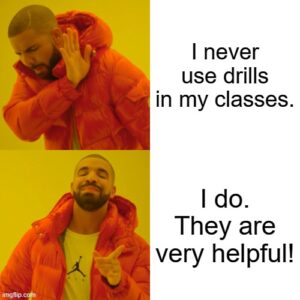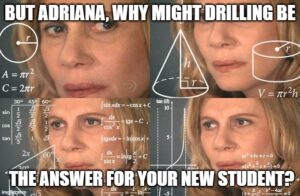Should I Use Drills in My ESL and EFL Lessons?
Are you the type of teacher who frequently uses drilling in your young ESL and EFL classes or, on the contrary, are you the one who considers it an obsolete strategy that creates robotic speakers?

Whatever your answer is, please give me the chance to share with you some interesting information I have recently learned about this topic.
Some weeks ago, I noticed that a new ESL third grader was having serious problems expressing herself, and despite being a spontaneous, young girl, she was having a hard time when telling her classmates about her routine and her everyday life. Her slow advance made me go back to my college years and dig into the drilling theory again.

Well, as you already know, I usually work with chunks of language repetition, and I often see a great improvement in my learner’s oral performance. However, this time it was different due to the fact that she didn’t seem to progress at the same pace as the rest of my new students.
Long story short…
I decided to re-read Scott Thornbury’s book “How to teach speaking” and I was not only able to identify where my problem was, but also, I could see other ways in which drilling could be helpful in our ESL and EFL lessons.
The author basically describes three main benefits of using drills, as well as five aspects to bear in mind when implementing them in our language classroom.
The first benefit is that drilling is an excellent instrument to use during the noticing stage of our lesson plans. It is useful not only when teaching grammar but also when teaching pronunciation. The selection and repetition of isolated phrases works as an anchor. Our learners have to be able to create and re-create similar structures or sounds. The second benefit the author highlights is the way a well-designed drilling exercise assists in the movement of information from the working memory to the long term one. This might be an excellent strategy to overcome those grammar and pronunciation fossilized errors some students have. Thirdly he mentions this is a great approach to make our children “get their tongue around it”: that’s why I’m using it every morning with the new student I mentioned at the beginning of this article. I generally practice with her several times before having our peer and group interaction moments, so that she feels prepared and much more confident when speaking. This daily training helps her to produce and retrieve the studied chunks of language in a smoother way.


Don’t worry! Thornbury’s analysis also adds five interesting suggestions a teacher should keep in mind to use drills effectively:
-
Work On Specific Phrases: Drill specific phrases taken from oral or written texts worked in class. It is not a good idea to drill complete dialogues since there will be too much information and the students won’t have a clear focus of improvement.
-
Comprehension is a Must: Make sure your students understand the meaning of each one of the sentences that are being drilled. It doesn’t make sense to repeat something we don’t understand and that we won’t be able to use in future situations. After drilling, challenge your students to adapt the learned chunks to new situations as this exercise expands their mind and enriches the learning strategies they already have.
-
Teach Stress and Intonation: When working on the sentences, make special emphasis on the stress and intonation. Remember that this is a game changer when dealing with native speakers and can even make them better learners.
-
Choral or Individual Drilling? Always involve choral and individual repetition. This permits your students to listen not only to their teacher but also their classmates and even to themselves. After our choral practice, I typically ask my students to drill with their classmates and make some peer correction. This exercise increases their sounds and structure awareness of the language.
-
Use Transcripts: After drilling, provide your students with a transcript and challenge them to find the sentences inside it. This is a great way to create the bridge between the oral and the written form of the language.
Despite the fact that drilling is frequently seen as an archaic and not very effective way to teach English, it might certainly be of great support when dealing with specific language problems such as accuracy and pronunciation. This can also be an excellent plan of action when teaching beginners or extremely slow learners.






Discussion about this post